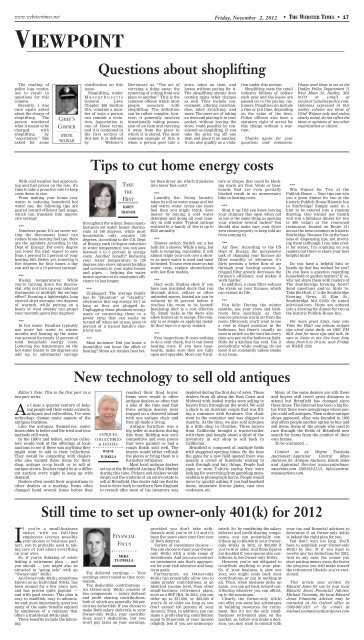November 02, 2012 - Southbridge Evening News
November 02, 2012 - Southbridge Evening News
November 02, 2012 - Southbridge Evening News
Create successful ePaper yourself
Turn your PDF publications into a flip-book with our unique Google optimized e-Paper software.
www.webstertimes.net Friday, <strong>November</strong> 2, <strong>2012</strong><br />
• THE WEBSTER TIMES • 17<br />
VIEWPOINT<br />
Questions about shoplifting<br />
The reading of<br />
police logs continues<br />
to result in<br />
questions for this<br />
column.<br />
Recently, I was<br />
once again asked<br />
about the charge of<br />
shoplifting. The<br />
person wondered<br />
what it meant to be<br />
charged with<br />
shoplifting by<br />
“asportation.” She<br />
asked for some<br />
CHIEF’S<br />
CORNER<br />
STEVE<br />
WOJNAR<br />
clarification on this<br />
issue.<br />
Shoplifting, under<br />
Massachusetts<br />
General Laws<br />
Chapter 266 Section<br />
30A, contains a number<br />
of ways a person<br />
can commit a violation.<br />
Asportation is<br />
one of these terms<br />
and it is contained in<br />
the first section of<br />
this law. It is defined<br />
by Webster’s<br />
Dictionary as “The act of<br />
carrying a thing away; the<br />
removing of a thing from one<br />
place to another.” This is the<br />
common offense which most<br />
people associate with<br />
shoplifting. The definition<br />
can be rather complex, however;<br />
it generally involves<br />
intentionally taking possession<br />
of an item and carrying<br />
it away from the place in<br />
which it is stored. The most<br />
common example of this is<br />
when a person goes into a<br />
store, takes an item, and<br />
leaves without paying for it.<br />
The shoplifting statute does<br />
contain many other charges<br />
as well. They include concealment,<br />
altering merchandise,<br />
label switching, and<br />
more. The mere act of taking<br />
an item and placing it in your<br />
pocket, without leaving the<br />
store, could possibly be considered<br />
as shoplifting. If you<br />
take the price tag off one<br />
item and place it on another,<br />
it can also qualify as a violation<br />
under this section.<br />
Shoplifting costs the retail<br />
industry billions of dollars<br />
each year and the losses are<br />
passed on to the paying customers.<br />
Penalties can include<br />
a fine or jail time, depending<br />
on the value of the item.<br />
Police officers also have a<br />
statutory right of arrest for<br />
this charge without a warrant.<br />
Thanks again for your<br />
questions and comments.<br />
Please send them to me at the<br />
Dudley Police Department 71<br />
West Main St. Dudley, MA<br />
01571 or e-mail at<br />
swojnar@dudleypolice.com.<br />
Opinions expressed in this<br />
weekly column are those of<br />
Chief Wojnar only and unless<br />
clearly noted, do not reflect the<br />
ideas or opinions of any other<br />
organization or citizen.<br />
Tips to cut home energy costs<br />
With cold weather fast approaching<br />
and fuel prices on the rise, it’s<br />
time to take a proactive role to keep<br />
costs down to size.<br />
From making your house cozy<br />
warm to reducing household hot<br />
water use, the following tips are<br />
geared toward efficient fuel usage,<br />
which can translate into impressive<br />
savings!<br />
***<br />
Numbers game: It’s no secret setting<br />
the thermostat lower can<br />
reduce home heating fuel use. Here<br />
are the numbers According to the<br />
Dept of Energy: For every degree<br />
you lower the dial, expect to save<br />
from 1 percent to 3 percent of your<br />
heating bill. Better yet, lowering it<br />
five degrees for four hours a day<br />
can add up to a 10 percent savings!<br />
***<br />
Rising temperatures: While<br />
you’re turning down the thermostat,<br />
why not turn up your internal<br />
thermostat to multiply the savings<br />
effect? Donning a lightweight, long<br />
sleeved shirt averages two degrees<br />
of warmth, while putting on a<br />
heavy or wool sweater can propel<br />
your warmth quota four degrees!<br />
***<br />
In hot water: Families typically<br />
use more hot water in winter<br />
months and heating up the water<br />
can account for nearly 15 percent of<br />
total household energy costs.<br />
Lowering the temperature on the<br />
hot water heater to 120 degrees can<br />
add up to substantial savings<br />
TAKE<br />
THE<br />
HINT<br />
KAREN<br />
TRAINOR<br />
throughout the winter. Some manufacturers<br />
set water heater thermostats<br />
at 140 degrees, while most<br />
households only require 120<br />
degrees. According to the U.S. Dept<br />
of Energy, each 10 degree reduction<br />
in water temperature, you can save<br />
between 3 to 5 percent in energy<br />
costs. Another benefit? Reducing<br />
your water temperature to 120<br />
degrees also slows mineral buildup<br />
and corrosion in your water heater<br />
and pipes — helping the water<br />
heater operate at its maximum efficiency<br />
to last longer.<br />
***<br />
Unplugged: The average family<br />
has 40 “phantom” or “standby”<br />
electronics that sap energy 24/7 as<br />
long as they are plugged in.<br />
Unplugging these phantom energy<br />
users or connecting them to a<br />
power strip that can easily be<br />
turned off when not in use, saves 10<br />
percent of a typical family’s electricity<br />
use.<br />
***<br />
Most moisture: Did you know a<br />
humidifier can boost the effect of<br />
heating? Moist air retains heat better<br />
than dryer air, which translates<br />
into lower fuel costs!<br />
***<br />
Laundry list: Doing laundry<br />
takes its toll on water usage and hot<br />
and warm water cycles use more<br />
fuel than you might think. Save<br />
money by buying a cold water<br />
detergent and doing all your laundry<br />
in cold water. Typical savings<br />
realized by a family of five is up to<br />
$250 annually.<br />
***<br />
Shower switch: Switch out a hot<br />
bath for a shower. While a long, hot<br />
bath is tempting, remember, it will<br />
almost triple your cost over a shower<br />
as more water is used and must<br />
be heated. To save even more on hot<br />
water costs, replace showerheads<br />
with low flow models.<br />
***<br />
Duct work: Studies show if you<br />
have non insulated ducts that run<br />
through attics, cellars or other<br />
unheated spaces, heated air can be<br />
reduced by 60 percent before it<br />
reaches the room to be heated!<br />
Insulating duct is a cost effective<br />
fix. Small leaks in the ducts also<br />
allow heated air to escape. The remedy<br />
is as simple as applying metallic<br />
duct tape or a spray sealant.<br />
***<br />
Free inspections: It costs nothing<br />
to do a vent check, but it can lower<br />
heating costs. If you have baseboards,<br />
make sure they are fully<br />
open and operable. Move any furniture<br />
or drapes that could be blocking<br />
warm air flow. Vents or baseboards<br />
that are even partially<br />
blocked result in an unnecessary<br />
hike in heating costs.<br />
***<br />
Shut it up: Did you know leaving<br />
your chimney flue open when not<br />
in use is the same thing as opening<br />
your window several inches? You<br />
should also make sure your dryer<br />
vent closes properly to keep cold air<br />
from coming in.<br />
***<br />
Air flow: According to the US<br />
Dept of Energy, the inexpensive<br />
task of changing your furnace air<br />
filter monthly or whenever it’s<br />
dirty permits a better flow of air<br />
through your heating system. A<br />
clogged filter greatly decreases the<br />
furnace’s efficiency and makes it<br />
work harder.<br />
In addition, a clean filter reduces<br />
the strain on your furnace, which<br />
can extend its life.<br />
***<br />
Fan folly: During the winter<br />
months, use your stove and bathroom<br />
fans sparingly, as they<br />
remove precious warm air from the<br />
room. Obviously, you’ll want to use<br />
a vent to dispel moisture in the<br />
bathroom, but there’s usually no<br />
need to switch on the vent fan every<br />
time you put on the bathroom light.<br />
Ditto for a kitchen fan vent. Use it<br />
periodically while cooking; do not<br />
leave it on constantly unless smoke<br />
is an issue.<br />
***<br />
Win Dinner for Two at the<br />
Publick House — Your tips can win<br />
you a great dinner for two at the<br />
historic Publick House Historic Inn<br />
in Sturbridge! Simply send in a<br />
hint to be entered into a random<br />
drawing. One winner per month<br />
will win a fabulous dinner for two<br />
(a $60 value) at the renowned<br />
restaurant, located on Route 131<br />
across the town common in historic<br />
Sturbridge. Because I’m in the business<br />
of dispensing tips, not inventing<br />
them (although I can take credit<br />
for some), I’m counting on you<br />
readers out there to share your best<br />
helpful hints!<br />
Do you have a helpful hint or<br />
handy tip that has worked for you?<br />
Do you have a question regarding<br />
household or garden matters? If so,<br />
why not share them with readers of<br />
The <strong>Southbridge</strong> <strong>Evening</strong> <strong>News</strong>?<br />
Send questions and/or hints to:<br />
Take the Hint!, C/o the <strong>Southbridge</strong><br />
<strong>Evening</strong> <strong>News</strong>, 25 Elm St.,<br />
<strong>Southbridge</strong>, MA 01550. Or e-mail<br />
kdrr@aol.com. Hints are entered<br />
into a drawing for dinner for two at<br />
the historic Publick House Inn.<br />
For more great hints, tune into<br />
Take the Hint! one minute snippet<br />
tips aired twice daily on ORC FM<br />
98.9. And for more tips and talk, be<br />
sure to listen to my live hour long<br />
show from 9 to 10 a.m. each Friday<br />
on WARE 1250.<br />
New technology to sell old antiques<br />
Editor’s Note: This is the first part in a<br />
two-part series.<br />
As I near a quarter century of helping<br />
people sell their estate contents,<br />
antiques and collectibles, I’ve seen<br />
technology change many aspects of the<br />
antiques business.<br />
Like the antiques themselves, sometimes<br />
older is better and the tried and true<br />
methods still work.<br />
In the 1980’s and before, serious collectors<br />
would look at the offerings at local<br />
auctions to see if there was anything they<br />
might want to add to their collections.<br />
They would be competing with dealers<br />
who also wanted these items for their<br />
shop, antique co-op booth or to sell at<br />
antique shows. Dealers might be at a different<br />
auction every night to keep up with<br />
demand.<br />
Dealers often resold their acquisitions to<br />
other dealers at a markup. Items often<br />
changed hand several times before they<br />
ANTIQUES,<br />
COLLECTIBLES<br />
& ESTATES<br />
WAYNE<br />
TUISKULA<br />
reached their final buyer.<br />
Items were resold to other<br />
antique dealers so often that<br />
a joke of the time said that<br />
three antique dealers were<br />
trapped on a deserted island<br />
with one antique chair and<br />
they all made a living.<br />
Antique furniture was a<br />
big seller at auctions during<br />
this time. Bidding was very<br />
competitive and even pieces<br />
that were painted or had a<br />
rough finish sold well. The<br />
buyers would either refinish<br />
the pieces or bring them to a<br />
furnisher refinisher.<br />
Most local antique dealers<br />
set up at the Brimfield Antique Flea Market<br />
during this time. Pickers and dealers would<br />
empty out the contents of an entire estate to<br />
sell at Brimfield. One dealer told me that he<br />
had to drive back to northern New England<br />
to restock after most of his inventory was<br />
depleted during the first day of sales. These<br />
dealers from all along the East Coast and<br />
Midwest with loaded trucks were selling to<br />
buyers from throughout the world. We sold<br />
a chair to an Austrian couple that was filling<br />
a container with furniture. Our chair<br />
went in the container and was shipped to<br />
Austria. At the time, we also sold antiques<br />
in a little shop in Charlton. Three buyers<br />
from California brought a tractor-trailer<br />
with them and bought about a third of the<br />
inventory in our shop to sell back in<br />
California.<br />
Brimfield is composed of multiple fields<br />
with staggered opening times. By the time<br />
the gates for a new field opened there was<br />
usually a crowd of hundreds waiting to<br />
rush through and buy things. People had<br />
signs or wore T-shirts saying they were<br />
looking for everything from gambling memorabilia<br />
to phonograph horns. People would<br />
move by quickly asking if you had baseball<br />
items, miniature license plates, cast iron<br />
cookware, etc.<br />
Many of the same dealers are still there<br />
and buyers still travel great distances to<br />
attend but Brimfield has changed since<br />
these times. The Internet has been a big factor.<br />
First there were newsgroups where people<br />
could sell antiques. Then online antique<br />
shops appeared. eBay was founded in 1995<br />
and offers people another option to buy and<br />
sell items. Some of the people who used to<br />
race through the fields of Brimfield now<br />
search for items from the comfort of their<br />
own homes.<br />
To be continued …<br />
Contact us at: Wayne Tuiskula<br />
Auctioneer/Appraiser Central Mass<br />
Auctions for Antique Auctions, Estate Sales<br />
and Appraisal Services www.centralmassauctions.com<br />
(508-612-6111), info@centralmassauctions.com.<br />
Still time to set up owner-only 401(k) for <strong>2012</strong><br />
If you’re a small-business<br />
owner, with no full-time<br />
employees (except possibly<br />
your spouse or business partner),<br />
you’re probably used to taking<br />
care of just about everything<br />
on your own.<br />
So, if you’re thinking of establishing<br />
a retirement plan — and<br />
you should — you might also be<br />
attracted to “going solo” with an<br />
“Owner-only” 401(k).<br />
An Owner-only 401(k), sometimes<br />
known as an Individual 401(k), has<br />
been around for a few years now,<br />
and has proven quite popular —<br />
and with good reason. This plan is<br />
easy to establish, easy to administer<br />
and, most importantly, gives you<br />
many of the same benefits enjoyed<br />
by employees of a company that<br />
offers a traditional 401(k) plan.<br />
These benefits include the following:<br />
FINANCIAL<br />
FOCUS<br />
MIKE<br />
TUOMALA<br />
Tax deferred earnings — Your<br />
earnings aren’t taxed as they accumulate.<br />
Tax deductible contributions —<br />
An Owner-only 401(k) consists of<br />
two components — salary deferral<br />
and profit sharing contributions,<br />
both of which are generally 100 percent<br />
tax deductible. If you choose to<br />
make Roth salary deferrals to your<br />
Owner-only 401(k), your contributions<br />
aren’t deductible, but you<br />
won’t pay taxes on your earnings,<br />
provided you don’t take withdrawals<br />
until you’re 59 1/2 and it’s<br />
been five years since your first year<br />
of Roth deferral.<br />
Variety of investment choices —<br />
You can choose to fund your Owneronly<br />
401(k) with a wide range of<br />
investments. And you can construct<br />
an investment mix that’s appropriate<br />
for your risk tolerance and longterm<br />
goals.<br />
Furthermore, an Owner-only<br />
401(k) can potentially allow you to<br />
make greater contributions, at an<br />
identical income level, than other<br />
small-business retirement plans,<br />
such as a SEP IRA. In <strong>2012</strong>, you can<br />
defer up to $17,000, or $22,500 if<br />
you’re 50 or older (as long as you<br />
don’t exceed 100 percent of your<br />
income). Then, in addition, you can<br />
make a profit-sharing contribution<br />
equal to 25 percent of your income<br />
(slightly less if you are unincorporated).<br />
So, by combining the salary<br />
deferral and profit-sharing components,<br />
you can potentially contribute<br />
up to $50,000 to your Owneronly<br />
401(k) in <strong>2012</strong>, or $55,000 if<br />
you’re 50 or older. And these figures<br />
are doubled if your spouse also contributes<br />
to the Owner-only 401(k).<br />
However, you’re not obligated to<br />
contribute anything to your plan.<br />
So, if your business is slow one<br />
year, you might scale back your<br />
contributions, or put in nothing at<br />
all. Then, when business picks up<br />
again, you can get back toward contributing<br />
whatever you can afford,<br />
up to the maximum.<br />
Clearly, the Owner-only 401(k)<br />
can offer you some key advantages<br />
in building resources for retirement.<br />
But it’s not the only smallbusiness<br />
retirement plan on the<br />
market, so, before you make a decision,<br />
you may want to consult with<br />
your tax and financial advisors to<br />
determine if an Owner-only 401(k)<br />
is indeed the right plan for you.<br />
But don’t wait too long. You’ll<br />
have to establish your Owner-only<br />
401(k) by Dec. 31 if you want to<br />
receive any tax deductions for <strong>2012</strong>.<br />
And in any case, the sooner you<br />
start putting money away, the faster<br />
the progress you will make toward<br />
the retirement lifestyle you’ve envisioned.<br />
This article was written by<br />
Edward Jones for use by your local<br />
Edward Jones Financial Advisor.<br />
Michael Tuomala, the local Edward<br />
Jones Financial Advisor, may be<br />
contacted at his Oxford office at<br />
(508)-987-5327 or by e-mail at<br />
michael.tuomala@edwardjones.com
















